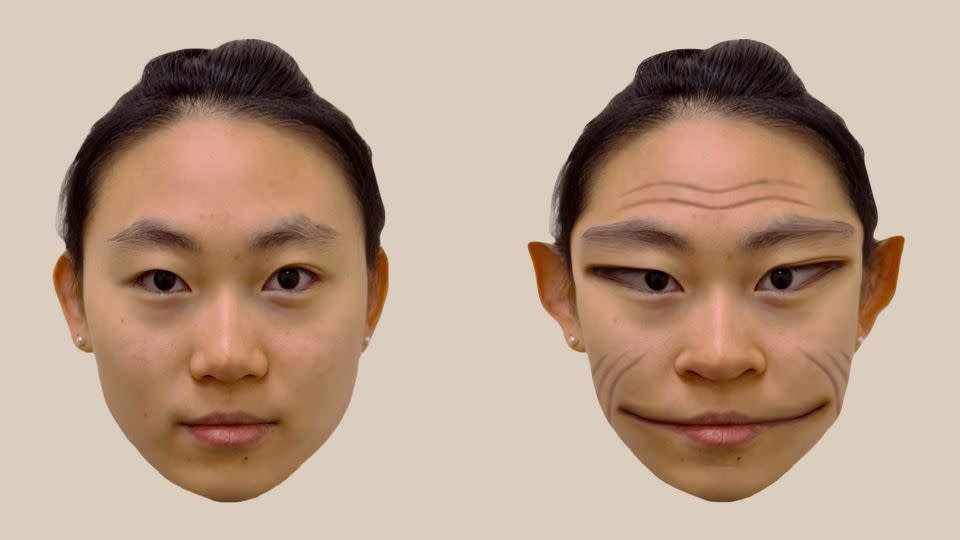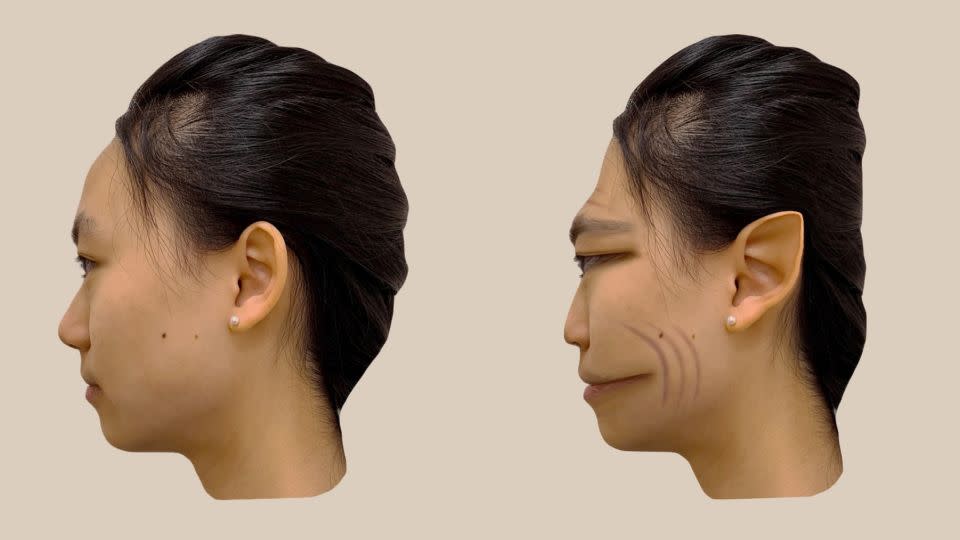‘It’s like staring at demons’: Meet a man who lives with a disturbing condition
For 59-year-old Victor Sharrah, the terrifying symptoms began on a winter day in Nashville.
“I just woke up and was sitting on the couch watching TV when my roommate came into the room, and (looking at him) I’m like, ‘What am I seeing?’ Then his girlfriend walked in and her face was the same,” Sharrah told CNN.
Each of the once-familiar faces had a grotesque grimace, elongated eyes and deeply etched scars. When turned to the side, pointy ears suddenly appeared, he said, much like those of Spock, the Vulcan first officer on the USS Enterprise in Star Trek.
“I tried to explain to my roommate what I was seeing, and he thought I was nuts. Then I went outside and all of the faces of people I saw were distorted and still are,” Sharrah said.
“It’s like staring at demons,” he added. “Imagine waking up one morning and suddenly everybody in the world looks like a creature in a horror movie.”
Sharrah has a rare condition called prosopometamorphopsia, or PMO, in which parts of the faces of other people appear distorted in shape, texture, position or color. Objects and other parts of a person’s body, however, typically remain undisturbed.
“I helped create a computer-generated 2D picture of what I see in faces, but there’s so much more to it,” said Sharrah, speaking about research on his case that was published in the “Clinical Pictures” section of The Lancet Thursday.
“What people don’t understand from a picture is that the distorted face is moving, contorting, talking to you, making facial gestures,” he added. “It does kind of distance me from other people a bit. I try not to let it because I know what it is, it’s PMO. Yet I still feel like I’m not getting as close to people as I used to.”

All types of distortions
Prosopometamorphopsia is different from “face blindness,” the condition shared by actor Brad Pitt, former Colorado governor John Hickenlooper, renowned neurologist Dr. Oliver Sacks, Sweden’s Crown Princess Victoria and perhaps as many as 1 in 50 people. In face blindness, faces are not distorted; instead the brain simply has trouble recognizing faces, even familiar faces — making nearly everyone a stranger.
With PMO, however, a person will often have little trouble recognizing a loved one or familiar face, yet that face will be distorted, often in predictable ways.
“For me the basic distortions are the same for each person, with the lines in the face, the stretching of the eyes and the mouth, and the pointy ears,” Sharrah said. “But the size and shape of a person’s face or head and how they move can be different and change just how distorted they might be.”
Some people with PMO see their own faces as distorted or even damaged. Two patients, “while standing in front of the mirror, saw one eye popping out of its socket and slithering down the cheek,” according to an April 2023 review of literature.
For others with the condition, like Victor, the entire face of another person appears misshapen, much like a “funhouse mirror,” according to a description in another published case study. Others see only half the face as crooked or malformed.
After a tumor was removed from the left side of his brain, one patient described the right side of his doctor’s face in which the “eye became a ghastly staring hole, cheek bone a cavity; he had teeth on the upper lip, often had two ears.” Others with PMO have eloquently described faces as “like clocks in a Dalí painting” or “kaleidoscopically changing.”
Still others have seen faces morph into dragons or fish heads, or ears pop out of the top of people’s heads. Some patients report seeing shortened arms attached to faces, people’s eyes leaving the skull and rotating in front of it, or third eyes in the middle of people’s foreheads.
“The woman who saw dragons began seeing them as a child, so there are development cases of PMO in which people grow up with the condition and don’t know that faces are supposed to look different,” said Brad Duchaine, a professor of psychological and brain sciences at Dartmouth College in Hanover, New Hampshire.
Only 81 cases of PMO exist in published literature, according to a June 2021 review, but there are likely many more people living with the condition, said Duchaine, the senior author on the Lancet case study.
“We started a website so people can learn about PMO, and we’ve heard from at least 80 people so far,” he said. “And we’re finding that people from around the world are reporting the same symptoms without knowing anything about others with the condition.”

With so little knowledge available, many people with PMO can be diagnosed with schizophrenia or other similar hallucinatory conditions and put on anti-psychotic medications or even institutionalized, said Antônio Vitor Reis Goncalves Mello, a doctoral student in psychological and brain sciences at Dartmouth, who is first author on the case study.
However, science now knows that people can develop PMO after a brain injury, tumor or infection, or after seizures such as in epilepsy, he said.
“A piece of good evidence is that in more than 50% of cases with half-face distortions, for example, the patient has a lesion to a particular part of the brain,” Mello said. “In those cases we’re confident they’re not making it up, so when other people come along and report very similar experiences it seems unlikely that they are not being truthful.”
‘Evil, twisted and demented’
Diagnosed with bipolar disorder as a teen, Sharrah struggled with mental illness that intensified into post-traumatic stress disorder (PTSD) after a stint in the US Marine Corps.
“I was in Beirut on October 23, 1983 when they bombed our barracks. And anytime something goes wrong in my life, my biggest battle is with suicidal psychosis — it’s the first place my brain turns,” he said.
As part of his coping, Sharrah has been a long-time member of a Facebook suicide support group. Increasingly fearful of what was happening to him after the distortions began, he posted his symptoms online.
“I feel like I’m shutting down. Like I’m dying inside. Every face I see that’s not on a screen looks evil, twisted and demented. I mean literally looks like something from a John Carpenter movie,” he wrote in January 2020.
“I’m growing cold, hateful and uncaring. I don’t know how to stop it. Maybe it’s too late.”
In Casper, Wyoming, Catherine Morris was waiting for a meeting to start and just happened to check Facebook, where she was a volunteer for the same suicide support group. Having worked in schools with the visually impaired for over 30 years, she was familiar with how people sometimes saw visual distortions based on how their brains perceived different colors and intensities of light.
“I saw his post pop up, and I thought what do I do? I can reach out and maybe I can help him, but I don’t want to give him false hope,” Morris said. “I told him that he had to promise me one thing — while we were working together, he couldn’t hurt himself.”
Morris knew from her training that such distortions could be triggered by a specific area of the brain called the fusiform gyrus, which is responsible for face perception, object recognition and reading. Light distorts, so the solution, she thought, might be finding a particular color or intensity of light that might reduce his symptoms.
“I’ve bought one of the multi-colored light bulbs with an app that Catherine was able to control from Wyoming,” Sharrah said. “Then we got on a video call and did a whole bunch of our own tests.”
Afraid for his mental health, Morris had asked Sharrah for his phone number and address before the tests because if “he became too upset, I was calling 911.”
Then she had him look into a mirror while she manipulated the colors of light.
“When I got to the wrong color of light, the red light that intensified the distortions, I watched it happen. He started to have a full on panic attack. He withdrew from the screen and the expression on his face was quite horrified,” Morris said.
“I told him to shut his eyes and remember that this wasn’t real, his brain was tricking him,” she said. “Then I moved the light to green and asked him to open his eyes. He did and the distortion was gone. And he just sat there and bawled like a baby.”
Boyed by their success, Morris ordered a pair of glasses tinted with the proper shade of green. Knowing that Sharrah was soon due to see his estranged daughter and meet his grandchildren for the first time, she sent them rush delivery.
“And they arrived the morning he met his granddaughters,” she said. “He got to meet them for the first time, and they looked normal.”
Treatment and education is the goal
Today, Sharrah is working closely with Duchaine and Mello at their Dartmouth lab, helping test various interventions to ease or reverse the symptoms of PMO.
The research has duplicated the benefits of green lenses in countering Sharrah’s symptoms and found that manipulating colors in lenses helped others with PMO as well — although the colors that work might differ. Another promising treatment – showing people with PMO completely symmetrical faces, which appears to reduce distortion.
“If that stands up to more testing, perhaps glasses can be made to help people see faces more symmetrically,” Mello said.
But one of the biggest breakthroughs came when the team realized that Sharrah did not see distortions on 2D images.
“Most of the participants with PMO will see distortions to faces in real life and faces on images, which has kept us from being able to capture exactly what they see,” Morro said. “With Victor, we were able to have him describe a real person’s face while (also) looking at an image of them that we manipulated” until it reflected the distortions he saw.
The research is “wonderful work,” and the first time that an accurate illustration of PMO has been captured, said psychiatrist Dr. Jan Dirk Blom, who heads the Outpatient Clinic for Uncommon Psychiatric Syndromes at Parnassia Psychiatric Institute in The Hague, Netherlands.
For Sharrah, the research is a way that he might help save another person from being misdiagnosed by doctors unaware of the rare syndrome.
“I almost had myself committed to a mental hospital, and one of the people who reached out to Dartmouth was institutionalized for psychosis. How many other people are institutionalized and being put on anti-psychotics when they’re not psychotic?”
For more CNN news and newsletters create an account at CNN.com

